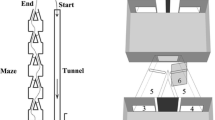Abstract
Learning in ants was studied in a multiple choice symmetrical maze at different levels of social food motivation.Myrmica rubra scout ants were found to be able to change their behavioral strategy rapidly when families were suddenly changed from a low level of motivation to a high level and vice versa. In the “sated” state, there was clearly evident investigative activity, which led to high levels of variability and instability in the maze habit. In the “starved” state, there was a rapid minimization of movement trajectories, and most ants used only one dominant movement scheme. The initial level of food motivation determined how ants learned in the maze and their ability to change their behavioral strategy.
Similar content being viewed by others
References
B. M. Dlusskii, “The principles of communication in ants,” in:Readings in Memory of N. A. Kholodkovskii [in Russian], Nauka, Leningrad (1981), p. 3.
G. M. Dlusskii, O. V. Voltsit, and A. V. Sulkhanov, “Organization of group foraging in ants of the genusFormica,”Zool. Zh.,57, No. 1, 65 (1978).
S. I. Zabelin, “Transmission of information on the direction of movement towards bait using a tactile code in the antTapinoma simrothi karavaevi,”Zool. Zh.,58, No. 8, 1168 (1979).
A. Ya. Karas', G. P. Udalova, and B. A. Dashevskii, “Some biological factors determining the functional organization of memory and learning,” in:The Study of Memory [in Russian], Nauka, Moscow (1990), p. 119.
A. Ya. Karas', G. P. Udalova, and B. A. Dashevskii, “The orientation of ants in a maze rotated in the horizontal plane,”Sensomye Sistemy,9, No. 2-3, 50 (1995).
A. Ya. Karas', G. P. Udalova, and E. V. Zagoraeva, “The role of motivation in learning inMymica rubra ants in a multiple choice maze,”Vestn. LGU [Leningradskogo Gosudarstvennogo Universiteta], No. 4, 43 (1986).
N. G. Lopatina,Signaling Activity in an Apis melifera Honey Bee Family [in Russian], Nauka, Leningrad (1971).
Yu. B. Manteifel', M. A. Karelina, and E. V. Khoroshilova, “Two forms of learning in fish using a single combination of conditioned and unconditioned stimuli,” in:Fish Behavior: Proceedings of the Second All-Russian Conference, Borok (1996), p. 54.
G. P. Udalova, M. I. Zhukovskaya, and A. Ya., Karas', “The ability ofMyrmica rubra ants to undergo multiple rearrangements in a maze habit,”Zhurn. Vyssh. Nerv. Deyat.,41, No. 6, 1154 (1991).
G. P. Udalova and A. Ya. Karas', “Spatial-movement asymmetry I ants,” in:The Neurobiology of Cerebral Lateralization [in Russian], Leningrad State University Press, Leningrad (1989), p. 173.
Author information
Authors and Affiliations
Additional information
Translated from Zhurnal Vysshei Nervnoi Deyatel'nosti, Vol. 48, No. 1, pp. 91–98, January–February, 1998.
Rights and permissions
About this article
Cite this article
Karas', A.Y., Udalova, G.P. Behavioral strategies in ants in changing conditions of food motivation. Neurosci Behav Physiol 29, 263–269 (1999). https://doi.org/10.1007/BF02465337
Received:
Revised:
Issue Date:
DOI: https://doi.org/10.1007/BF02465337




